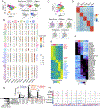Ovarian cancer immunogenicity is governed by a narrow subset of progenitor tissue-resident memory T cells
- PMID: 35427494
- PMCID: PMC9096229
- DOI: 10.1016/j.ccell.2022.03.008
Ovarian cancer immunogenicity is governed by a narrow subset of progenitor tissue-resident memory T cells
Abstract
Despite repeated associations between T cell infiltration and outcome, human ovarian cancer remains poorly responsive to immunotherapy. We report that the hallmarks of tumor recognition in ovarian cancer-infiltrating T cells are primarily restricted to tissue-resident memory (TRM) cells. Single-cell RNA/TCR/ATAC sequencing of 83,454 CD3+CD8+CD103+CD69+ TRM cells and immunohistochemistry of 122 high-grade serous ovarian cancers shows that only progenitor (TCF1low) tissue-resident T cells (TRMstem cells), but not recirculating TCF1+ T cells, predict ovarian cancer outcome. TRMstem cells arise from transitional recirculating T cells, which depends on antigen affinity/persistence, resulting in oligoclonal, trogocytic, effector lymphocytes that eventually become exhausted. Therefore, ovarian cancer is indeed an immunogenic disease, but that depends on ∼13% of CD8+ tumor-infiltrating T cells (∼3% of CD8+ clonotypes), which are primed against high-affinity antigens and maintain waves of effector TRM-like cells. Our results define the signature of relevant tumor-reactive T cells in human ovarian cancer, which could be applicable to other tumors with unideal mutational burden.
Keywords: immuno-oncology; neoantigen; ovarian cancer; tissue-resident memory-like T cell; tumor-infiltrating lymphocyte.
Copyright © 2022 The Authors. Published by Elsevier Inc. All rights reserved.
Conflict of interest statement
Declaration of interests J.R.C.-G. has stock options with Compass Therapeutics, Anixa Biosciences, and Alloy Therapeutics; receives honorarium from Anixa Biosciences, Alloy Therapeutics, and Leidos; and has sponsored research with Anixa Biosciences (all outside the submitted work). B.A.P. has served on the Advisory Board of AstraZeneca and has research support from BMS. J.R.C.-G. is currently an employee of STEMCELL Technologies (all work outside the submitted work). R.M.W. reports grants and personal fees from Merck, personal fees from Tesaro/GSK, personal fees from Genentech, personal fees from Legend Biotech, personal fees from AbbVie, personal fees from Astrazeneca, grants and stock from Ovation Diagnostics, personal fees from Clovis Oncology, and personal fees from Regeneron (all outside the submitted work).
Figures






Comment in
-
Tissue residency of memory CD8+ T cells matters in shaping immunogenicity of ovarian cancer.Cancer Cell. 2022 May 9;40(5):452-454. doi: 10.1016/j.ccell.2022.04.008. Epub 2022 May 9. Cancer Cell. 2022. PMID: 35537410 Free PMC article.
-
Big fish in small ponds: Narrow repertoires of stem-like tissue-resident T cells yield great power in anti-tumor immunity.Immunity. 2022 Jun 14;55(6):979-981. doi: 10.1016/j.immuni.2022.05.017. Immunity. 2022. PMID: 35705001
References
-
- Amsen D, van Gisbergen K, Hombrink P, and van Lier RAW (2018). Tissue-resident memory T cells at the center of immunity to solid tumors. Nat Immunol 19, 538–546. - PubMed
-
- Baddeley A, and Turner R (2005). spatstat: An R Package for Analyzing Spatial Point Patterns. Journal of Statistical Software 12, 1 – 42.
-
- Baddeley A, and Turner R (2006). Modelling Spatial Point Patterns in R. In Case Studies in Spatial Point Process Modeling, Baddeley A, Gregori P, Mateu J, Stoica R, and Stoyan D, eds. (New York, NY: Springer New York; ), pp. 23–74.
Publication types
MeSH terms
Grants and funding
- R01 CA233512/CA/NCI NIH HHS/United States
- K08 CA231454/CA/NCI NIH HHS/United States
- U01 CA232758/CA/NCI NIH HHS/United States
- P30 CA010815/CA/NCI NIH HHS/United States
- T32 CA009140/CA/NCI NIH HHS/United States
- R01 CA211913/CA/NCI NIH HHS/United States
- P30 CA076292/CA/NCI NIH HHS/United States
- R01 CA240434/CA/NCI NIH HHS/United States
- R01 CA157664/CA/NCI NIH HHS/United States
- K99 CA266947/CA/NCI NIH HHS/United States
- R01 CA262121/CA/NCI NIH HHS/United States
- R01 CA178687/CA/NCI NIH HHS/United States
- R01 CA124515/CA/NCI NIH HHS/United States
- R01 CA184185/CA/NCI NIH HHS/United States
LinkOut - more resources
Full Text Sources
Other Literature Sources
Medical
Molecular Biology Databases
Research Materials

